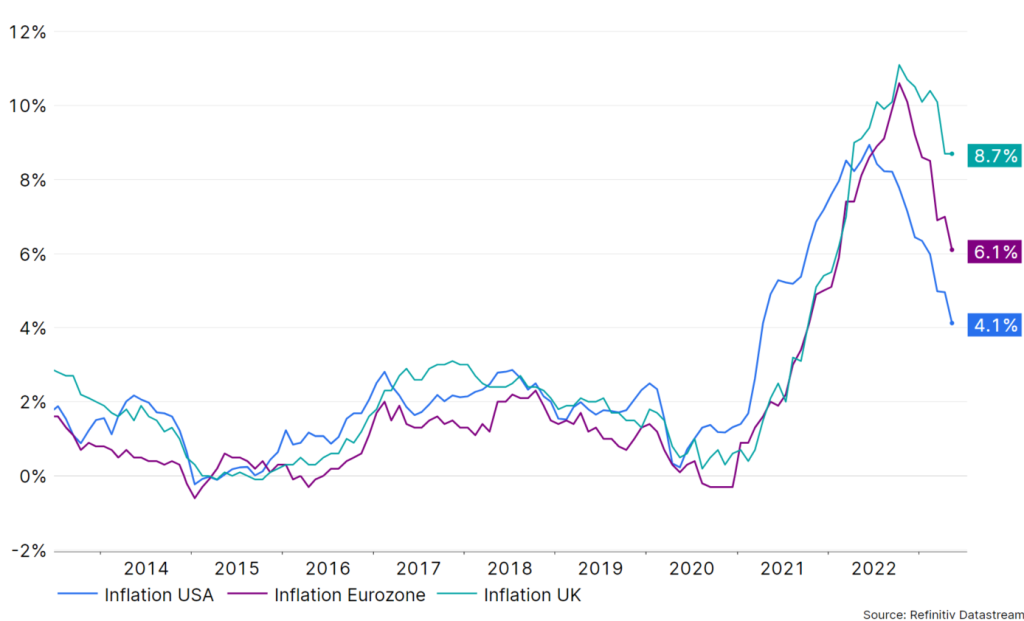The feared recession has so far failed to materialise and inflation is also falling. For risky securities, above all equities, this brings support. But the risks remain on the downside. What could be in store for the markets in the second half of the year?
Growth
On the positive side, most indicators still point to weak real economic growth in the developed economies (around 1% quarter-on-quarter and annualised).
The flash estimates of purchasing managers’ indices for some major economies also paint a similar picture. Overall, however, the reports were disappointing for two reasons:
- the manufacturing sector remains weak – indicators point to continued stagnation.
- the service sector shows signs of cooling – in the past months it had still supported growth.
Particularly in the eurozone, purchasing managers’ data were weak. The region has already been stagnating in this respect since the fourth quarter of 2022.
Even though the probability of an immediate recession is low, the indicators point to continued low growth. The weakening momentum in the service sector poses a further risk in this regard.
“Technical” vs. “Real” Recession
The Leading Economic Index, an important indicator of growth in the US economy, recently provided indications of a contraction in gross domestic product (GDP). However, stagnation or even a slight GDP contraction for a few quarters would not be a “real” recession. Some people refer to this as a “technical” recession.
By contrast, a “real” recession would be a sharp and prolonged broad-based deterioration. Declines in corporate profits lead to lower investment and lower employment. This reduces income, which in turn reduces consumption. A downward spiral is set in motion. Experience shows that this environment is the main enemy of equities.
Monetary policy
Recessions can have many causes. Currently, however, the central banks’ restrictive monetary policy is at the centre of attention. Past and future interest rate hikes have a dampening effect on growth only after a time lag. The duration and strength of this effect are uncertain.
The effect on inflation is even more uncertain. However, past experience shows that a restrictive monetary policy to curb inflation has often triggered a recession.
Inflation
The slow decline in inflation in recent weeks has led central banks to raise their inflation expectations. In line with this, the guidance for future key interest rates, the so-called forward guidance, has been raised again.
Next week, the flash estimate of consumer price inflation for June will be published in the Eurozone. The estimate for the core inflation rate, i.e. excluding the traditionally volatile components food and energy, is 5.5% yoy, up from 5.3% in May.
Key interest rates
Also due to higher inflation expectations, further key rate hikes in the euro zone are likely. Currently, the market expects another 50 basis points this year. The ECB’s main refinancing rate would then be 4.5%.
The Bank of England in the United Kingdom recently surprised with a strong rate hike of 0.5 percentage points to 5%. Previously, inflation had been surprisingly high at 8.7% year-on-year in May. Meanwhile, market prices reflect further hikes of more than one percentage point by the end of the year.
The world’s main central bank, the Fed, remains equally hawkish in its fight against inflation. The US central bank did leave key interest rates unchanged in June for the first time in this interest rate cycle. The upper band for the key interest rate is currently 5.25%. However, this is merely intended to stretch the path of interest rate hikes. In his semi-annual speeches to congressional committees, Fed Chairman Jerome Powell has put further rate hikes on the table.
Inflation rates are falling, but remain well above the central banks’ target.
Development over the past 10 years / data as of 28.06.2023

Source: Refinitiv Datastream; Note: Past performance is not a reliable indicator of future performance.
Should inflation stabilise above the central bank target of 2%, for example at 3%, the reasons could be structural. Demographic change means a tight labour market and climate change and geostrategic tensions imply higher investment activity. The possible productivity-boosting effect of new technologies, above all artificial intelligence, is still open.
It is possible that central banks will either implicitly or explicitly accept higher inflation. The consequence would be that they do not continuously pursue a restrictive policy. As long as inflation then fluctuates little around the new value, this would be a favourable scenario for the financial market.
Conclusion
True, the probability of an immediate recession is low. However, it would be bold to assume that inflation will continue to fall towards the central bank’s target of 2% without “pain”.
But even stagnation or a technical recession would probably not have particularly negative consequences for the financial markets.
The most important threat scenario for the markets continues to be the restrictive monetary policy of the central banks. This could dampen demand until a recession is triggered. The probability of this is uncomfortably high.
For a glossary of technical terms, please visit this link: Fund Glossary | Erste Asset Management
Legal note:
Prognoses are no reliable indicator for future performance.
Legal disclaimer
This document is an advertisement. Unless indicated otherwise, source: Erste Asset Management GmbH. The language of communication of the sales offices is German and the languages of communication of the Management Company also include English.
The prospectus for UCITS funds (including any amendments) is prepared and published in accordance with the provisions of the InvFG 2011 as amended. Information for Investors pursuant to § 21 AIFMG is prepared for the alternative investment funds (AIF) administered by Erste Asset Management GmbH pursuant to the provisions of the AIFMG in conjunction with the InvFG 2011.
The currently valid versions of the prospectus, the Information for Investors pursuant to § 21 AIFMG, and the key information document can be found on the website www.erste-am.com under “Mandatory publications” and can be obtained free of charge by interested investors at the offices of the Management Company and at the offices of the depositary bank. The exact date of the most recent publication of the prospectus, the languages in which the fund prospectus or the Information for Investors pursuant to Art 21 AIFMG and the key information document are available, and any other locations where the documents can be obtained are indicated on the website www.erste-am.com. A summary of the investor rights is available in German and English on the website www.erste-am.com/investor-rights and can also be obtained from the Management Company.
The Management Company can decide to suspend the provisions it has taken for the sale of unit certificates in other countries in accordance with the regulatory requirements.
Note: You are about to purchase a product that may be difficult to understand. We recommend that you read the indicated fund documents before making an investment decision. In addition to the locations listed above, you can obtain these documents free of charge at the offices of the referring Sparkassen bank and the offices of Erste Bank der oesterreichischen Sparkassen AG. You can also access these documents electronically at www.erste-am.com.
Our analyses and conclusions are general in nature and do not take into account the individual characteristics of our investors in terms of earnings, taxation, experience and knowledge, investment objective, financial position, capacity for loss, and risk tolerance. Past performance is not a reliable indicator of the future performance of a fund.
Please note: Investments in securities entail risks in addition to the opportunities presented here. The value of units and their earnings can rise and fall. Changes in exchange rates can also have a positive or negative effect on the value of an investment. For this reason, you may receive less than your originally invested amount when you redeem your units. Persons who are interested in purchasing units in investment funds are advised to read the current fund prospectus(es) and the Information for Investors pursuant to § 21 AIFMG, especially the risk notices they contain, before making an investment decision. If the fund currency is different than the investor’s home currency, changes in the relevant exchange rate can positively or negatively influence the value of the investment and the amount of the costs associated with the fund in the home currency.
We are not permitted to directly or indirectly offer, sell, transfer, or deliver this financial product to natural or legal persons whose place of residence or domicile is located in a country where this is legally prohibited. In this case, we may not provide any product information, either.
Please consult the corresponding information in the fund prospectus and the Information for Investors pursuant to § 21 AIFMG for restrictions on the sale of the fund to American or Russian citizens.
It is expressly noted that this communication does not provide any investment recommendations, but only expresses our current market assessment. Thus, this communication is not a substitute for investment advice.
This document does not represent a sales activity of the Management Company and therefore may not be construed as an offer for the purchase or sale of financial or investment instruments.
Erste Asset Management GmbH is affiliated with the Erste Bank and austrian Sparkassen banks.
Please also read the “Information about us and our securities services” published by your bank.


